CHCECE013 Use Information About Children to Inform Practice Solution
VerifiedAdded on 2023/03/30
|24
|3559
|361
Homework Assignment
AI Summary
This document presents a student's solution to an assessment for the CHCECE013 unit, focusing on using information about children to inform practice in early childhood education. The assessment includes short answer questions covering topics such as the importance of observation, types of narrative observations, challenges in observation and assessment, and ethical considerations. It also features case studies designed to assess the student's understanding of social and language development in children, and a research activity. The solutions provided offer insights into understanding child behaviors, planning appropriate learning experiences, and maintaining professional standards in early childhood settings. This resource can be helpful for students seeking to understand the core concepts of CHCECE013 and improve their assessment outcomes. Desklib provides a platform for students to access various study resources, including solved assignments and past papers.
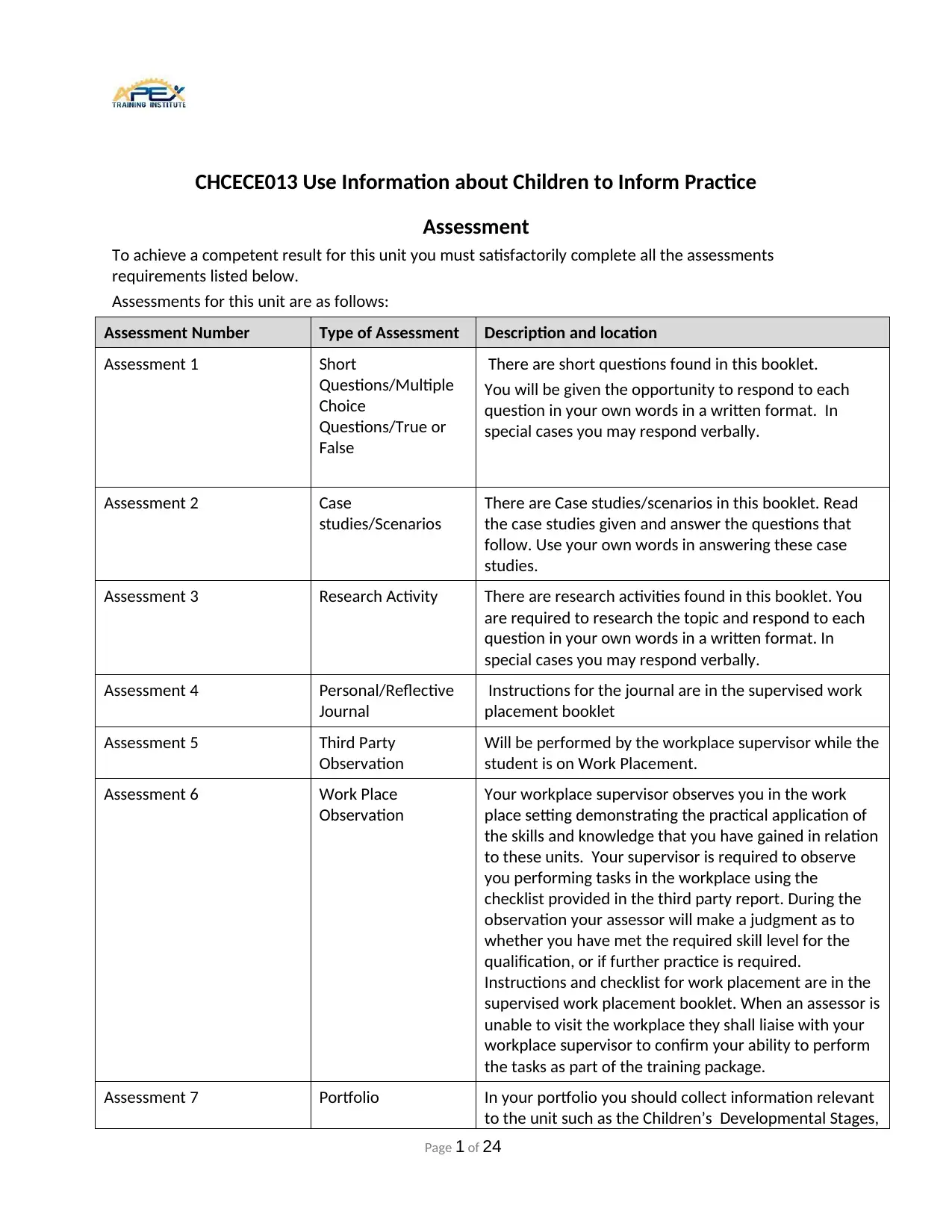
CHCECE013 Use Information about Children to Inform Practice
Assessment
To achieve a competent result for this unit you must satisfactorily complete all the assessments
requirements listed below.
Assessments for this unit are as follows:
Assessment Number Type of Assessment Description and location
Assessment 1 Short
Questions/Multiple
Choice
Questions/True or
False
There are short questions found in this booklet.
You will be given the opportunity to respond to each
question in your own words in a written format. In
special cases you may respond verbally.
Assessment 2 Case
studies/Scenarios
There are Case studies/scenarios in this booklet. Read
the case studies given and answer the questions that
follow. Use your own words in answering these case
studies.
Assessment 3 Research Activity There are research activities found in this booklet. You
are required to research the topic and respond to each
question in your own words in a written format. In
special cases you may respond verbally.
Assessment 4 Personal/Reflective
Journal
Instructions for the journal are in the supervised work
placement booklet
Assessment 5 Third Party
Observation
Will be performed by the workplace supervisor while the
student is on Work Placement.
Assessment 6 Work Place
Observation
Your workplace supervisor observes you in the work
place setting demonstrating the practical application of
the skills and knowledge that you have gained in relation
to these units. Your supervisor is required to observe
you performing tasks in the workplace using the
checklist provided in the third party report. During the
observation your assessor will make a judgment as to
whether you have met the required skill level for the
qualification, or if further practice is required.
Instructions and checklist for work placement are in the
supervised work placement booklet. When an assessor is
unable to visit the workplace they shall liaise with your
workplace supervisor to confirm your ability to perform
the tasks as part of the training package.
Assessment 7 Portfolio In your portfolio you should collect information relevant
to the unit such as the Children’s Developmental Stages,
Page 1 of 24
Assessment
To achieve a competent result for this unit you must satisfactorily complete all the assessments
requirements listed below.
Assessments for this unit are as follows:
Assessment Number Type of Assessment Description and location
Assessment 1 Short
Questions/Multiple
Choice
Questions/True or
False
There are short questions found in this booklet.
You will be given the opportunity to respond to each
question in your own words in a written format. In
special cases you may respond verbally.
Assessment 2 Case
studies/Scenarios
There are Case studies/scenarios in this booklet. Read
the case studies given and answer the questions that
follow. Use your own words in answering these case
studies.
Assessment 3 Research Activity There are research activities found in this booklet. You
are required to research the topic and respond to each
question in your own words in a written format. In
special cases you may respond verbally.
Assessment 4 Personal/Reflective
Journal
Instructions for the journal are in the supervised work
placement booklet
Assessment 5 Third Party
Observation
Will be performed by the workplace supervisor while the
student is on Work Placement.
Assessment 6 Work Place
Observation
Your workplace supervisor observes you in the work
place setting demonstrating the practical application of
the skills and knowledge that you have gained in relation
to these units. Your supervisor is required to observe
you performing tasks in the workplace using the
checklist provided in the third party report. During the
observation your assessor will make a judgment as to
whether you have met the required skill level for the
qualification, or if further practice is required.
Instructions and checklist for work placement are in the
supervised work placement booklet. When an assessor is
unable to visit the workplace they shall liaise with your
workplace supervisor to confirm your ability to perform
the tasks as part of the training package.
Assessment 7 Portfolio In your portfolio you should collect information relevant
to the unit such as the Children’s Developmental Stages,
Page 1 of 24
Paraphrase This Document
Need a fresh take? Get an instant paraphrase of this document with our AI Paraphraser

Playground policies etc.
Page 2 of 24
Page 2 of 24

Instructions to the Student
Please read all the information given to you before you start any assessment task. If you do not
understand some or all of the questions, please ask your trainer/assessor for assistance.
Attempt to answer ALL questions in your own words on the assessment paper provided. The questions
are designed to assess your understanding of the unit as well as your underpinning knowledge. To
satisfactorily complete this assessment task you are required to complete the whole assessment. To do
this you will need to answer all questions correctly and demonstrate you have achieved the required
knowledge to industry standards. This assessment is intended to be fair and flexible. If you feel that we
should change any aspect of this assessment to be fair, equitable or flexible, immediately contact your
assessor who will attempt to make alternative arrangements.
Page 3 of 24
Please read all the information given to you before you start any assessment task. If you do not
understand some or all of the questions, please ask your trainer/assessor for assistance.
Attempt to answer ALL questions in your own words on the assessment paper provided. The questions
are designed to assess your understanding of the unit as well as your underpinning knowledge. To
satisfactorily complete this assessment task you are required to complete the whole assessment. To do
this you will need to answer all questions correctly and demonstrate you have achieved the required
knowledge to industry standards. This assessment is intended to be fair and flexible. If you feel that we
should change any aspect of this assessment to be fair, equitable or flexible, immediately contact your
assessor who will attempt to make alternative arrangements.
Page 3 of 24
⊘ This is a preview!⊘
Do you want full access?
Subscribe today to unlock all pages.

Trusted by 1+ million students worldwide
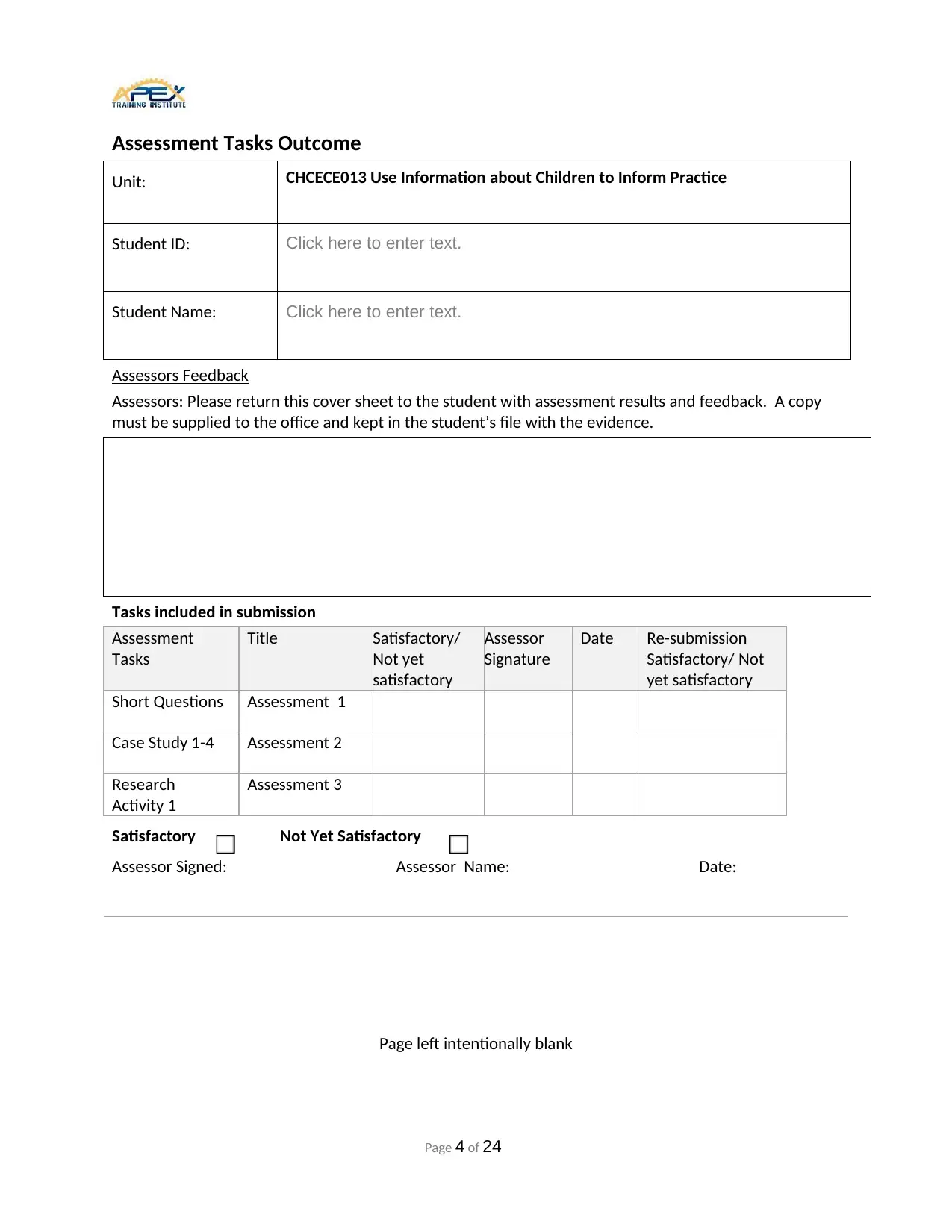
Assessment Tasks Outcome
Unit: CHCECE013 Use Information about Children to Inform Practice
Student ID: Click here to enter text.
Student Name: Click here to enter text.
Assessors Feedback
Assessors: Please return this cover sheet to the student with assessment results and feedback. A copy
must be supplied to the office and kept in the student’s file with the evidence.
Tasks included in submission
Assessment
Tasks
Title Satisfactory/
Not yet
satisfactory
Assessor
Signature
Date Re-submission
Satisfactory/ Not
yet satisfactory
Short Questions Assessment 1
Case Study 1-4 Assessment 2
Research
Activity 1
Assessment 3
Satisfactory Not Yet Satisfactory
Assessor Signed: Assessor Name: Date:
Page left intentionally blank
Page 4 of 24
Unit: CHCECE013 Use Information about Children to Inform Practice
Student ID: Click here to enter text.
Student Name: Click here to enter text.
Assessors Feedback
Assessors: Please return this cover sheet to the student with assessment results and feedback. A copy
must be supplied to the office and kept in the student’s file with the evidence.
Tasks included in submission
Assessment
Tasks
Title Satisfactory/
Not yet
satisfactory
Assessor
Signature
Date Re-submission
Satisfactory/ Not
yet satisfactory
Short Questions Assessment 1
Case Study 1-4 Assessment 2
Research
Activity 1
Assessment 3
Satisfactory Not Yet Satisfactory
Assessor Signed: Assessor Name: Date:
Page left intentionally blank
Page 4 of 24
Paraphrase This Document
Need a fresh take? Get an instant paraphrase of this document with our AI Paraphraser

Page 5 of 24
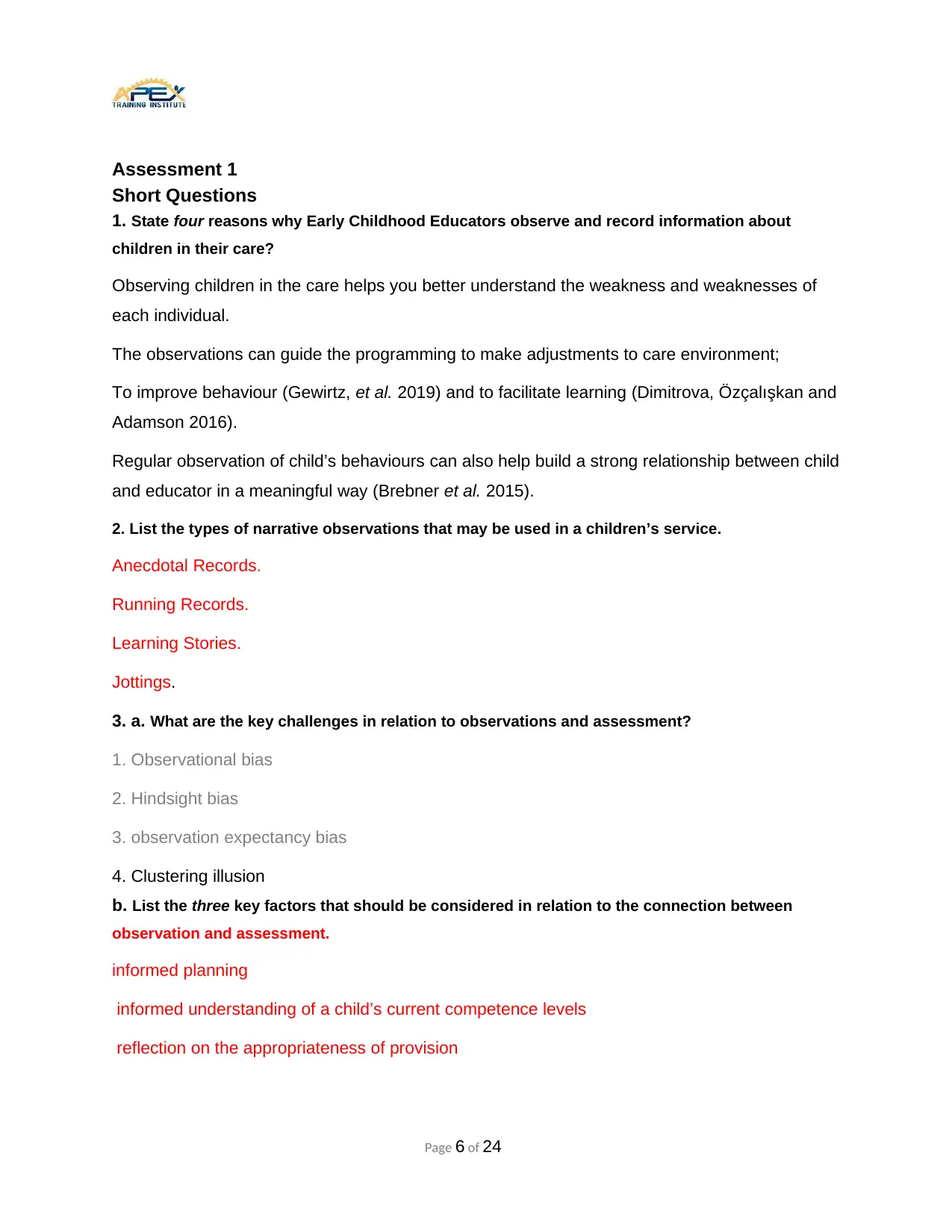
Assessment 1
Short Questions
1. State four reasons why Early Childhood Educators observe and record information about
children in their care?
Observing children in the care helps you better understand the weakness and weaknesses of
each individual.
The observations can guide the programming to make adjustments to care environment;
To improve behaviour (Gewirtz, et al. 2019) and to facilitate learning (Dimitrova, Özçalışkan and
Adamson 2016).
Regular observation of child’s behaviours can also help build a strong relationship between child
and educator in a meaningful way (Brebner et al. 2015).
2. List the types of narrative observations that may be used in a children’s service.
Anecdotal Records.
Running Records.
Learning Stories.
Jottings.
3. a. What are the key challenges in relation to observations and assessment?
1. Observational bias
2. Hindsight bias
3. observation expectancy bias
4. Clustering illusion
b. List the three key factors that should be considered in relation to the connection between
observation and assessment.
informed planning
informed understanding of a child’s current competence levels
reflection on the appropriateness of provision
Page 6 of 24
Short Questions
1. State four reasons why Early Childhood Educators observe and record information about
children in their care?
Observing children in the care helps you better understand the weakness and weaknesses of
each individual.
The observations can guide the programming to make adjustments to care environment;
To improve behaviour (Gewirtz, et al. 2019) and to facilitate learning (Dimitrova, Özçalışkan and
Adamson 2016).
Regular observation of child’s behaviours can also help build a strong relationship between child
and educator in a meaningful way (Brebner et al. 2015).
2. List the types of narrative observations that may be used in a children’s service.
Anecdotal Records.
Running Records.
Learning Stories.
Jottings.
3. a. What are the key challenges in relation to observations and assessment?
1. Observational bias
2. Hindsight bias
3. observation expectancy bias
4. Clustering illusion
b. List the three key factors that should be considered in relation to the connection between
observation and assessment.
informed planning
informed understanding of a child’s current competence levels
reflection on the appropriateness of provision
Page 6 of 24
⊘ This is a preview!⊘
Do you want full access?
Subscribe today to unlock all pages.

Trusted by 1+ million students worldwide
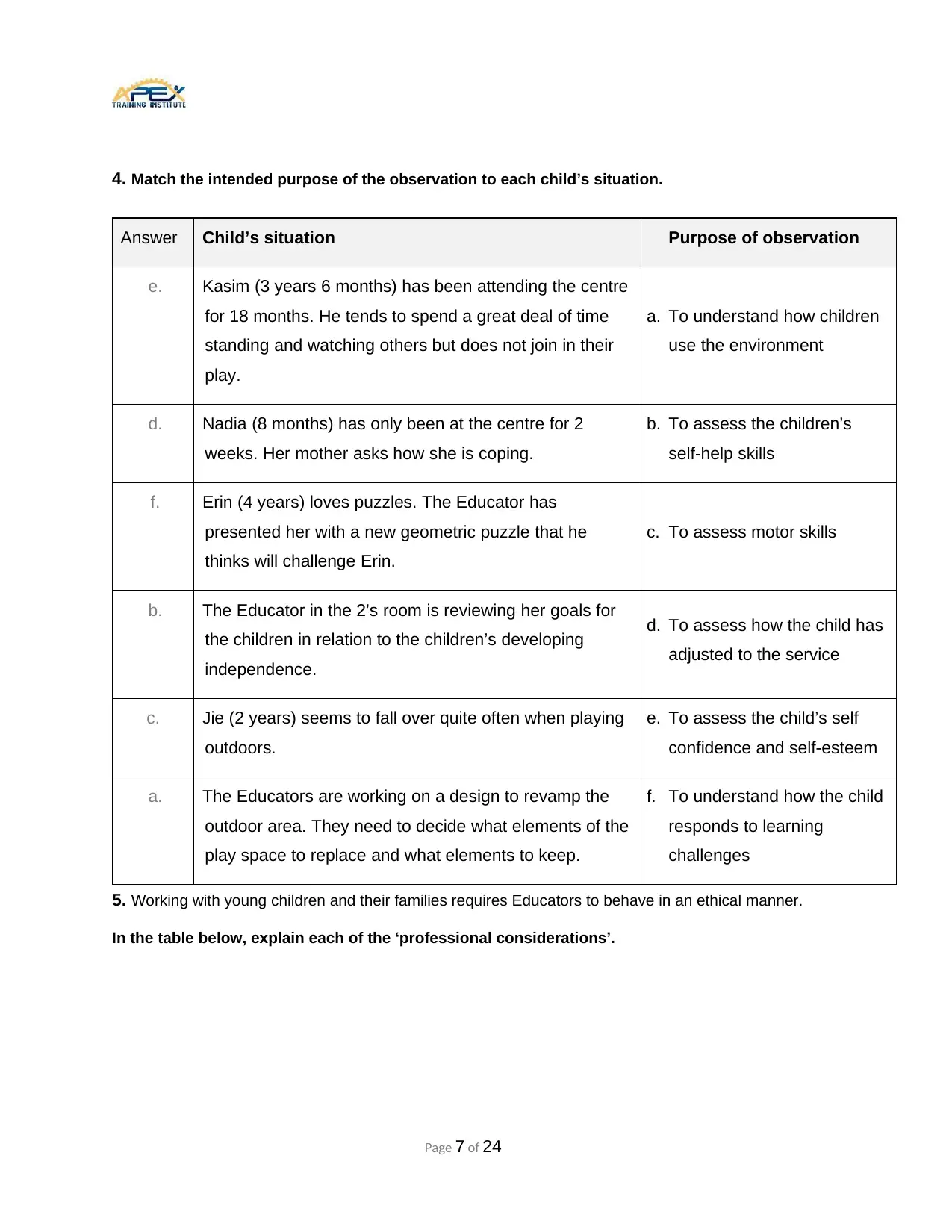
4. Match the intended purpose of the observation to each child’s situation.
Answer Child’s situation Purpose of observation
e. Kasim (3 years 6 months) has been attending the centre
for 18 months. He tends to spend a great deal of time
standing and watching others but does not join in their
play.
a. To understand how children
use the environment
d. Nadia (8 months) has only been at the centre for 2
weeks. Her mother asks how she is coping.
b. To assess the children’s
self-help skills
f. Erin (4 years) loves puzzles. The Educator has
presented her with a new geometric puzzle that he
thinks will challenge Erin.
c. To assess motor skills
b. The Educator in the 2’s room is reviewing her goals for
the children in relation to the children’s developing
independence.
d. To assess how the child has
adjusted to the service
c. Jie (2 years) seems to fall over quite often when playing
outdoors.
e. To assess the child’s self
confidence and self-esteem
a. The Educators are working on a design to revamp the
outdoor area. They need to decide what elements of the
play space to replace and what elements to keep.
f. To understand how the child
responds to learning
challenges
5. Working with young children and their families requires Educators to behave in an ethical manner.
In the table below, explain each of the ‘professional considerations’.
Page 7 of 24
Answer Child’s situation Purpose of observation
e. Kasim (3 years 6 months) has been attending the centre
for 18 months. He tends to spend a great deal of time
standing and watching others but does not join in their
play.
a. To understand how children
use the environment
d. Nadia (8 months) has only been at the centre for 2
weeks. Her mother asks how she is coping.
b. To assess the children’s
self-help skills
f. Erin (4 years) loves puzzles. The Educator has
presented her with a new geometric puzzle that he
thinks will challenge Erin.
c. To assess motor skills
b. The Educator in the 2’s room is reviewing her goals for
the children in relation to the children’s developing
independence.
d. To assess how the child has
adjusted to the service
c. Jie (2 years) seems to fall over quite often when playing
outdoors.
e. To assess the child’s self
confidence and self-esteem
a. The Educators are working on a design to revamp the
outdoor area. They need to decide what elements of the
play space to replace and what elements to keep.
f. To understand how the child
responds to learning
challenges
5. Working with young children and their families requires Educators to behave in an ethical manner.
In the table below, explain each of the ‘professional considerations’.
Page 7 of 24
Paraphrase This Document
Need a fresh take? Get an instant paraphrase of this document with our AI Paraphraser

Professional Consideration Explanation
Confidentiality Maintaining the child’s confidentiality increases self- perception, self-
identity in the child. It also helps to address privacy and esteem needs.
Recording /documenting
without bias
There are different biases that comes to play while researching on a
group or recording someone’s behaviour. It is important to keep these
biases out of the calculation because on the whole and at last – it
makes a great difference to the assessment. For educators – it is
critically important to be self-aware and be impartial with doing the
analysis.
Correct use of spelling,
grammar and punctuation
The syntax is very important aspect of verbal learning. Incorporation of
wrong spellings or wrong grammar can get embedded in the child’s
mind and hence , using immaculate syntax and sentence structures is
very necessary.
Avoiding jargon and
generalisations
Jargons are something which gives an effect when enough knowledge
about the subject is already acquired and it holds no ‘true’ meaning for a
child who is at the beginning of education. Generalisations can too an
adverse effect on true learning as it digresses from the essence of
making a child know a word’s true intensity and impact.
Page 8 of 24
Confidentiality Maintaining the child’s confidentiality increases self- perception, self-
identity in the child. It also helps to address privacy and esteem needs.
Recording /documenting
without bias
There are different biases that comes to play while researching on a
group or recording someone’s behaviour. It is important to keep these
biases out of the calculation because on the whole and at last – it
makes a great difference to the assessment. For educators – it is
critically important to be self-aware and be impartial with doing the
analysis.
Correct use of spelling,
grammar and punctuation
The syntax is very important aspect of verbal learning. Incorporation of
wrong spellings or wrong grammar can get embedded in the child’s
mind and hence , using immaculate syntax and sentence structures is
very necessary.
Avoiding jargon and
generalisations
Jargons are something which gives an effect when enough knowledge
about the subject is already acquired and it holds no ‘true’ meaning for a
child who is at the beginning of education. Generalisations can too an
adverse effect on true learning as it digresses from the essence of
making a child know a word’s true intensity and impact.
Page 8 of 24

6. Read each statement and indicate whether it is objective or subjective?
Objective: Presents facts without opinion
Subjective: Represents personal opinion which may not be accurate
Statement
a. Anwar (4 years) is a selfish boy. Objective
b. Olivia (2 years) is very spoilt, she always wants everything her own way! Subjectiv
e
c. Leo (12 months) finds it difficult to settle into a sleep routine. Objective
d. Tilly (3 years) never does as she is asked, she is very willful. Subjectiv
e
e. Cara (4 years 9 months) has poor receptive language skills. Objective
7. The following statements would be considered as unprofessional.
Match each statement with the descriptor that best defines why the statement is unprofessional.
Descriptors:
a. Educator is demonstrating cultural bias.
b. Educator demonstrates lack of respect for child/family.
c. Educator is making assumptions that may or may not be correct.
d. Educator is making a personal value judgment.
Descriptor Statement
d. Brooke (2 years 3 months) is extremely spoilt. She screams and tantrums if
her needs are not met immediately.
Page 9 of 24
Objective: Presents facts without opinion
Subjective: Represents personal opinion which may not be accurate
Statement
a. Anwar (4 years) is a selfish boy. Objective
b. Olivia (2 years) is very spoilt, she always wants everything her own way! Subjectiv
e
c. Leo (12 months) finds it difficult to settle into a sleep routine. Objective
d. Tilly (3 years) never does as she is asked, she is very willful. Subjectiv
e
e. Cara (4 years 9 months) has poor receptive language skills. Objective
7. The following statements would be considered as unprofessional.
Match each statement with the descriptor that best defines why the statement is unprofessional.
Descriptors:
a. Educator is demonstrating cultural bias.
b. Educator demonstrates lack of respect for child/family.
c. Educator is making assumptions that may or may not be correct.
d. Educator is making a personal value judgment.
Descriptor Statement
d. Brooke (2 years 3 months) is extremely spoilt. She screams and tantrums if
her needs are not met immediately.
Page 9 of 24
⊘ This is a preview!⊘
Do you want full access?
Subscribe today to unlock all pages.

Trusted by 1+ million students worldwide
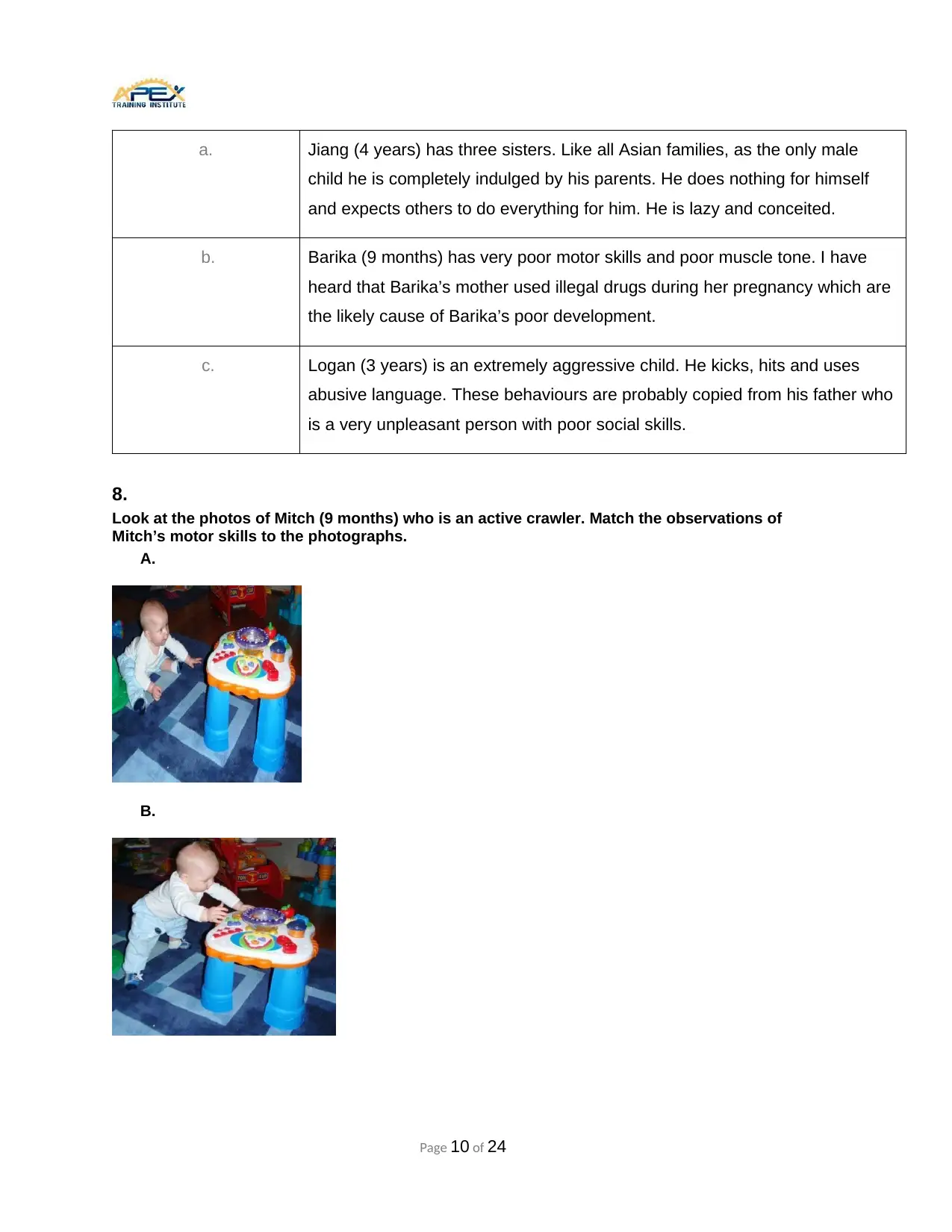
a. Jiang (4 years) has three sisters. Like all Asian families, as the only male
child he is completely indulged by his parents. He does nothing for himself
and expects others to do everything for him. He is lazy and conceited.
b. Barika (9 months) has very poor motor skills and poor muscle tone. I have
heard that Barika’s mother used illegal drugs during her pregnancy which are
the likely cause of Barika’s poor development.
c. Logan (3 years) is an extremely aggressive child. He kicks, hits and uses
abusive language. These behaviours are probably copied from his father who
is a very unpleasant person with poor social skills.
8.
Look at the photos of Mitch (9 months) who is an active crawler. Match the observations of
Mitch’s motor skills to the photographs.
A.
B.
Page 10 of 24
child he is completely indulged by his parents. He does nothing for himself
and expects others to do everything for him. He is lazy and conceited.
b. Barika (9 months) has very poor motor skills and poor muscle tone. I have
heard that Barika’s mother used illegal drugs during her pregnancy which are
the likely cause of Barika’s poor development.
c. Logan (3 years) is an extremely aggressive child. He kicks, hits and uses
abusive language. These behaviours are probably copied from his father who
is a very unpleasant person with poor social skills.
8.
Look at the photos of Mitch (9 months) who is an active crawler. Match the observations of
Mitch’s motor skills to the photographs.
A.
B.
Page 10 of 24
Paraphrase This Document
Need a fresh take? Get an instant paraphrase of this document with our AI Paraphraser
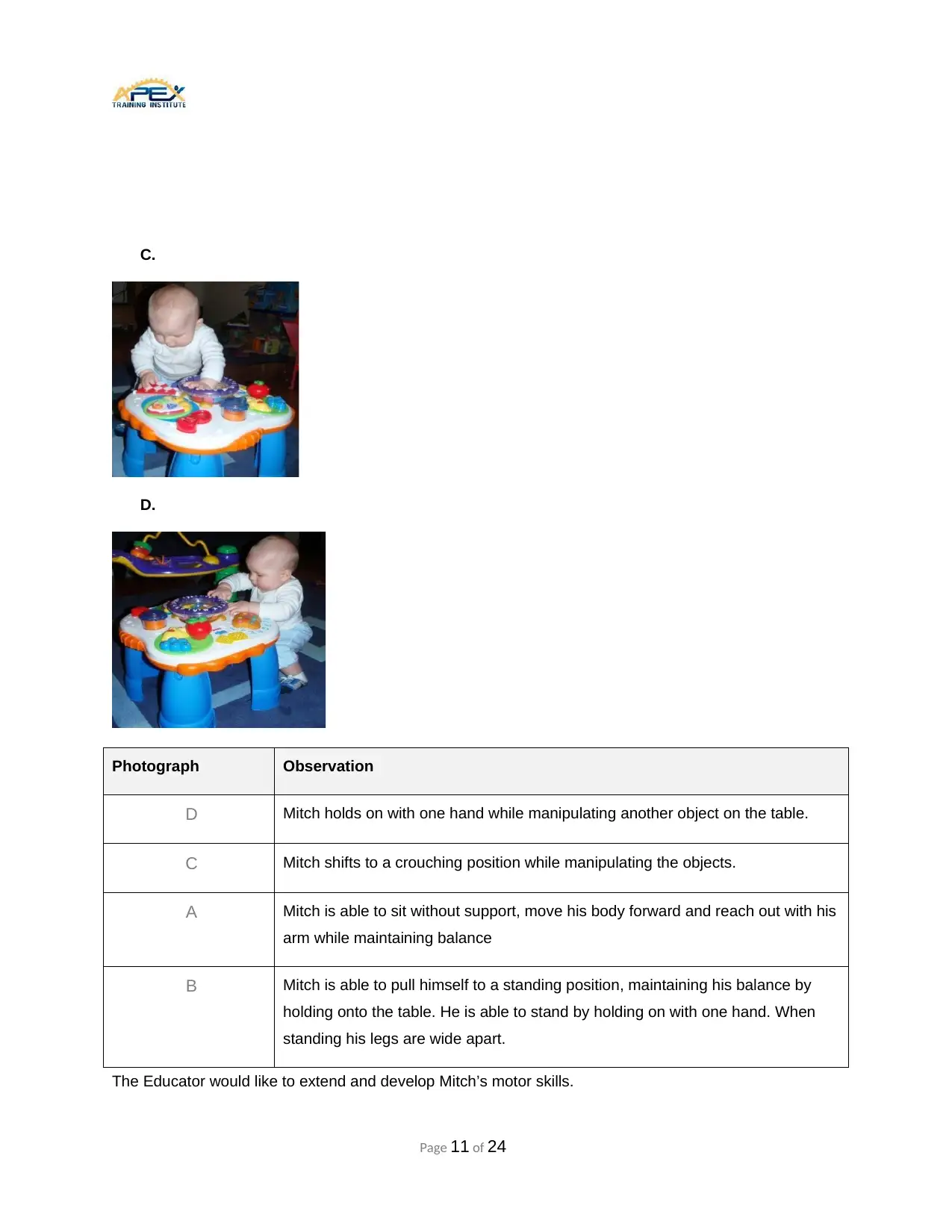
C.
D.
Photograph Observation
D Mitch holds on with one hand while manipulating another object on the table.
C Mitch shifts to a crouching position while manipulating the objects.
A Mitch is able to sit without support, move his body forward and reach out with his
arm while maintaining balance
B Mitch is able to pull himself to a standing position, maintaining his balance by
holding onto the table. He is able to stand by holding on with one hand. When
standing his legs are wide apart.
The Educator would like to extend and develop Mitch’s motor skills.
Page 11 of 24
D.
Photograph Observation
D Mitch holds on with one hand while manipulating another object on the table.
C Mitch shifts to a crouching position while manipulating the objects.
A Mitch is able to sit without support, move his body forward and reach out with his
arm while maintaining balance
B Mitch is able to pull himself to a standing position, maintaining his balance by
holding onto the table. He is able to stand by holding on with one hand. When
standing his legs are wide apart.
The Educator would like to extend and develop Mitch’s motor skills.
Page 11 of 24
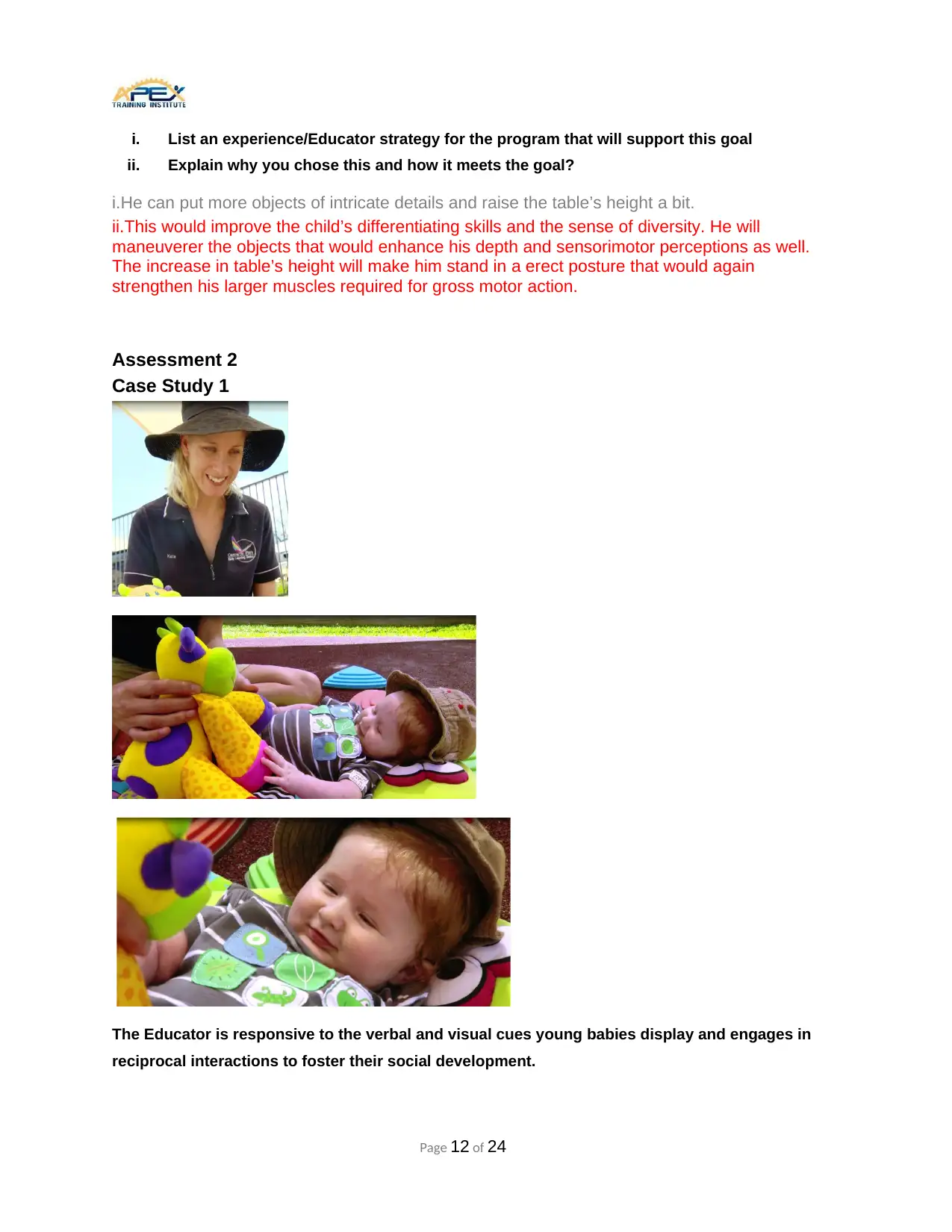
i. List an experience/Educator strategy for the program that will support this goal
ii. Explain why you chose this and how it meets the goal?
i.He can put more objects of intricate details and raise the table’s height a bit.
ii.This would improve the child’s differentiating skills and the sense of diversity. He will
maneuverer the objects that would enhance his depth and sensorimotor perceptions as well.
The increase in table’s height will make him stand in a erect posture that would again
strengthen his larger muscles required for gross motor action.
Assessment 2
Case Study 1
The Educator is responsive to the verbal and visual cues young babies display and engages in
reciprocal interactions to foster their social development.
Page 12 of 24
ii. Explain why you chose this and how it meets the goal?
i.He can put more objects of intricate details and raise the table’s height a bit.
ii.This would improve the child’s differentiating skills and the sense of diversity. He will
maneuverer the objects that would enhance his depth and sensorimotor perceptions as well.
The increase in table’s height will make him stand in a erect posture that would again
strengthen his larger muscles required for gross motor action.
Assessment 2
Case Study 1
The Educator is responsive to the verbal and visual cues young babies display and engages in
reciprocal interactions to foster their social development.
Page 12 of 24
⊘ This is a preview!⊘
Do you want full access?
Subscribe today to unlock all pages.

Trusted by 1+ million students worldwide
1 out of 24
Related Documents
Your All-in-One AI-Powered Toolkit for Academic Success.
+13062052269
info@desklib.com
Available 24*7 on WhatsApp / Email
![[object Object]](/_next/static/media/star-bottom.7253800d.svg)
Unlock your academic potential
Copyright © 2020–2025 A2Z Services. All Rights Reserved. Developed and managed by ZUCOL.





